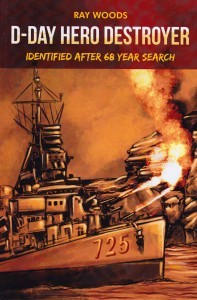 By Ray Woods, RoseDogBooks, Pittsburgh, PA (2013).
By Ray Woods, RoseDogBooks, Pittsburgh, PA (2013).
Reviewed by Charles Bogart
This book might be best classified as an autobiography of Ray Woods’s service on USS O’Brien (DD 725) from 1943 to 1945. During this period, O’Brien saw action in both Pacific and Atlantic theaters of warfare. O’Brien was off the Normandy beachhead during the 1944 invasion where she was damaged by German coast artillery. Woods was the only enlisted man not wounded within CIC. He then went to the Pacific where he took part in the liberation of the Philippines, engaged kamikazes off Okinawa, and participated in the occupation of Japan. Woods was burned by a fire started by kamikaze aircraft at Okinawa.
The subtitle of the book, Identified After 68 Year Search, is the result of extensive research conducted by the author into why O’Brien did not receive credit for providing close gunfire support during the initial landings at Normandy. He states that the success of the landing was made possible by O’Brien closing up to the beach to knock out German machine gun nets and artillery positions. Woods was always puzzled as to why O’Brien never received credit for this action in books written about the Normandy Invasion. He discovered that none of these gunfire events are recorded in O’Brien’s ship log and after-action report for June 6, 1944. He believes this is because the captain disobeyed orders and left his assigned position to help soldiers landing ashore. To cover up this fact, Woods thinks the written records of what O’Brien did on D-Day were sanitized, leaving gaps between recorded events.
The book contains a number of photographs of the officers and men of O’Brien and copies of official reports and newspaper clippings. These photos and documents make up half of the book. Unfortunately, some of the copies of these reproduced documents are out of focus and hard to read. Overall, the book is an interesting read of one man’s service on a World War II destroyer. This account might be better written for the enjoyment of his extended family. Those interested in what service was like on a destroyer during World War II should enjoy this book.
Charles H. Bogart is a frequent contributor to Naval History Book Reviews.


gerri hash
Adam